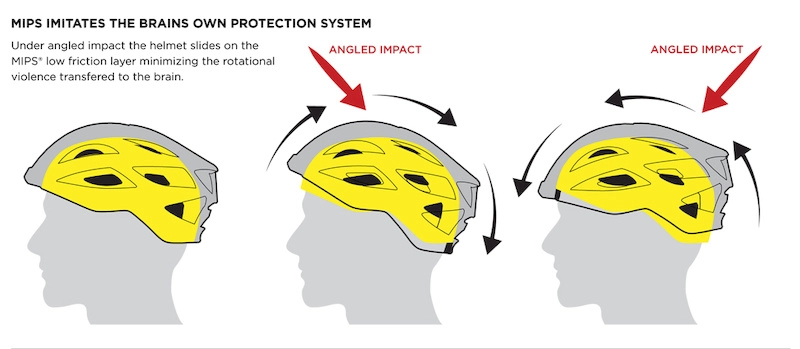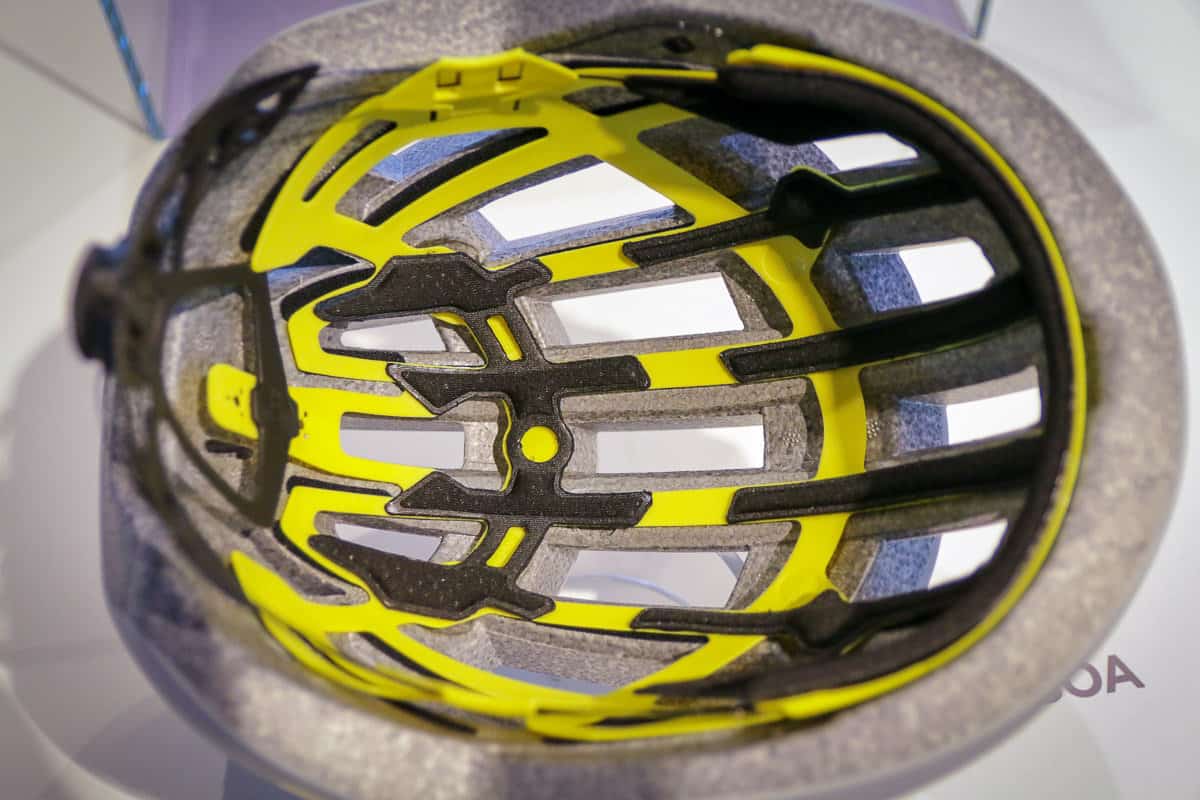
As cyclists, we are always looking for ways to improve our safety on the road. The helmet is one of the most critical safety equipment for cyclists.
In recent years, there has been a lot of talk about MIPS helmets and how they can provide extra protection in the event of a crash.
You may have noticed that many cycling helmets come with a yellow MIPS sticker on the back. That designation and a yellow insert inside the helmet designate it as a helmet with MIPS technology.
I’ll discuss what is MIPS in detail below for you to decide if it’s worth getting a helmet with MIPS.
Key takeaways
- MIPS, or Multi-directional Impact Protection System, is an advanced helmet technology developed to reduce rotational forces on the brain during angled impacts. It works through a low-friction layer inside the helmet that allows a small amount of rotational movement, potentially reducing brain injury risk.
- MIPS helmets usually cost 10% to 20% more than regular helmets, translating to an extra $15 to $25 on average. This added cost reflects the inclusion of the MIPS technology, which many helmet manufacturers believe enhances safety based on the science and data behind MIPS.
Definition of MIPS
MIPS is an acronym that stands for Multi-directional Impact Protection System. It’s a helmet safety technology designed to better protect the brain in an accident where your head collides with a hard surface and an angle.
While traditional helmets are effective at absorbing impact forces from head-on collisions, they are not as effective at protecting the brain from rotational forces. This is where MIPS comes in.
By reducing rotational forces, MIPS can help to reduce the risk of severe brain injuries. While more helmet manufacturers are adding MIPS technology to their products, it doesn’t come with government safety endorsements, like today’s helmet standards, such as CE and CPSC.
It’s important to note that MIPS technology and helmet standards are separate. As of writing, MIPS technology is an add-on feature to bike helmets.
How does MIPS work?

MIPS allows a small amount of rotational movement between the helmet and the head upon impact. This is achieved through a low-friction layer inside the helmet that can slide relative to the head. When a MIPS helmet is subjected to an angled impact, the low-friction layer allows the helmet to slide, which can reduce the amount of rotational force that may be transferred to the user’s brain.
Rotational force can cause strain to the brain during an impact and potentially result in damage. By allowing the helmet to move slightly, MIPS can help to mitigate the risk of brain injuries resulting from these rotational forces.
Who invented MIPS?

Swedish neurosurgeon Dr. Hans von Holst and engineer Peter Halldin are credited as the inventors of MIPS helmet technology.
In the mid-1990s, Dr. Hans von Holst was seeing too many traumatic brain injuries but was concerned that not enough was being done to prevent those accidents from happening in the first place.
Dr. Hans von Holst led the research at Karolinska University Hospital on creating a new helmet technology. However, he ultimately felt the technical work with his medical colleagues was getting in the way of developing a product.
So, Dr. Hans von Holst went to KTH Royal Institute of Technology, where he met Peter Halldin and ultimately convinced Peter to help him tackle the project. Peter was so energized by the idea that he pursued a Ph.D. in biomechanics, using the MIPS project as his primary research point during his studies.
Does MIPS lead to a safer helmet?
Traumatic brain injuries and concussions don’t occur solely at the point of an aggressive impact. It’s the rotational forces that ultimately cause these severe issues. That’s what MIPS solely set out to solve.
Halldin and Hans von Holst tested their technology in 2001 on a police helmet, and the results were astounding. The rotational forces were reduced by 50%, meaning half of all bike crashes could avoid concussions or severe brain injuries if the rider wore a helmet with a MIPS insert.
That was undoubtedly an encouraging piece of data, but does the MIPS technology make today’s helmets safer?
Well, it’s not a simple yes or no answer. Instead of using the word safer, the engineers and doctors behind MIPS today prefer to speak about its technology in terms of its handling of rotational impact.
They guarantee that any helmet equipped with MIPS technology can better handle rotational impact by at least 10%. If it’s any less, MIPS won’t allow its technology inside that particular helmet.
When MIPS describes its technology as handling the rotational impact better, it means cutting down on the computed strain on the brain when an angled point of impact occurs.
Although there are helmets out there that can handle rotational impact by as much as 60% better, no one will tell you which helmet.
These decisions come down to liability and potential lawsuits. Suppose someone sustained a traumatic brain injury and knew they were wearing a helmet that advertised itself as able to eliminate concussions by as much as 60%. In that case, there’s a chance that the victim could sue the helmet manufacturer for false advertising.
Of course, a 10% improvement in handling rotational impact is better than nothing. So, technically, a helmet with MIPS technology is safer than a standard helmet.
Do MIPS helmets cost more?

MIPS helmets cost slightly more, but the cost is relatively unsubstantial for increased safety.
Remember, MIPS isn’t a helmet. It’s an insert that goes inside a helmet. The company behind MIPS works with bike helmet manufacturers and convinces them to sell their helmets at a higher price to pay for the technology.
In the past, helmet brands such as Giro and Lazer would sell two different versions of the same helmet. One would have MIPS; the other wouldn’t. Today, most helmet brands have decided it’s worth including MIPS technology in their helmets, which is an endorsement of the technology.
How much more does a MIPS helmet cost?
The typical premium for a bike helmet with MIPS technology ranges from $15 to $25, or 10% to 20% more.
You’re looking at about $80 to $120 for a higher-quality bike helmet, depending on the brand.
Are MIPS helmets worth the money?
Determining whether a MIPS helmet is worth the extra money is down to individual decisions.
The main challenge with MIPS today is that several associations, including the Bicycle Helmet Safety Institute, are still on the fence about whether or not MIPS technology protects cyclists’ brains more than standard helmets. The organization said there isn’t enough data on the technology at this point.
That said, helmet brands aren’t necessarily getting richer by including MIPS technology. They must pay the company behind MIPS to include the insert in their helmet.
So, why are many of the top helmet makers including the technology?
In my opinion, I like to think it’s because they believe in the data and the science behind MIPS. So, is an extra $15 to $20 for a bike helmet worth it if your chances of getting a concussion are reduced anywhere from 10% to 60%?

Alex Lee is the founder and editor-at-large of Mr. Mamil. Coming from a professional engineering background, he breaks down technical cycling nuances into an easy-to-understand and digestible format here.
He has been riding road bikes actively for the past 12 years and started racing competitively in the senior category during the summer recently.